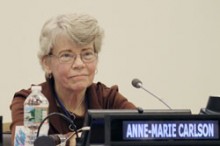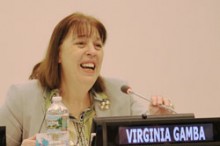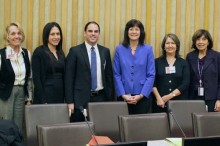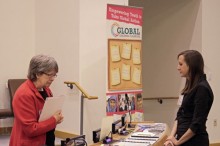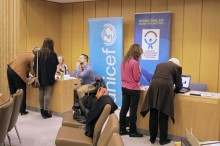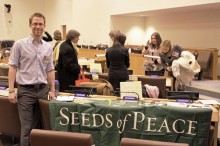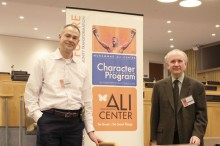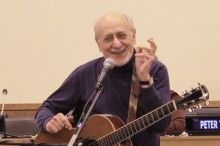2014 UN
15th Annual CTAUN Conference, 31 January 2014 – United Nations, NY
PROMOTING PEACE THROUGH EDUCATION
It is not enough to teach children how to read, write and count. Education has to cultivate mutual respect for others and the world in which we live, and help people forge more just, inclusive and peaceful societies.
~~ UN Secretary-General Ban Ki-moon 12 June 2013
CONFERENCE REPORT
Opening Video: To Save Succeeding Generations from the Scourge of War: http://vimeo.com/67838241
WELCOME by Anne-Marie Carlson, Chair
The conference was opened by CTAUN Chair Anne-Marie Carlson, who welcomed 466 conference participants, including 34 Fulbright scholars from Africa, Europe, Asia, the Middle East and South America, engaged as Teaching Assistants in 29 American colleges and universities as well as groups of educators and students from Nassau Community College on Long Island, and E. Stroudsburg High School in Stroudsburg, PA.
In her opening remarks, Ms Carlson stressed the importance of going beyond promoting peace to actually achieving it, and began by showing a powerful video entitled Determined to Save Succeeding Generations from the Scourge of War – an 11 minute graphic and moving portrayal of what war feels like to innocent people. It highlights the fact that 41 million people have been displaced by recent conflicts, while $1.7 trillion per year has been allotted to global military spending. This is 630 times the UN budget for development. It is estimated that less than half of these funds spent on the military would have paid for all the Millennium Development Goals by 2015. Underlining this fact is a Thomas Mann quote from the film, “ War is a coward’s escape from the problems of peace.” (You can view the UN Charter, from which the film’s title comes, online at www.un.org/en/documents/charter/index.shtml )
OPENING KEYNOTE: Virginia Gamba, Director and Deputy to the UN High Representative for Disarmament Affairs
www.un.org/disarmament
Ms. Gamba began by talking about her concern that more is being said about disarmament than is being done. She pointed out that there are too few courses in colleges and universities, or training programs for young people wishing to enter the field, too few syllabi, dissertations, professional articles, scholarly books etc.
Almost 20,000 nuclear weapons remain in the world, despite the Nuclear Non-Proliferation Treaty entered into 44 years ago, and though member states possessing nuclear weapons have long-term plans underway to modernize their arsenals or their delivery systems, there are still no plans for disarmament. She quoted Secretary-General Ban Ki-moon saying: “The world is over-armed, and peace is under-funded,” adding that efforts toward disarmament are largely voluntary. She gave as examples International NGOs such as ICAN – the International Campaign to Abolish Nuclear Weapons www.icanpeacework.org and Global Zero, www.globalzero.org , religious groups, resolutions from the Inter-Parliamentary Union, and the Mayors for Peace initiative, with representatives of over 5800 cities worldwide in 158 countries.
On the grass-roots level, women’s groups and physicians, publicizing the presence of radioactive materials in babies’ teeth and mothers’ milk from atmospheric testing in the late 1950’s, led to the launching of the Partial Test Ban Treaty of 1963. But this is not enough. She stressed the role of educators in promoting peace. “Education is the most powerful weapon we can use to change the world” (Nelson Mandela) and explained Secretary-General Kofi Annan’s three-pronged role for university educators in particular:
- discovery – through research about nuclear arsenals and possible poor management at nuclear sites that would address public concerns
- teaching – about the technical challenges of verification for future inspectors, and the political challenges for future legislators and leaders, of how to get treaties ratified by parliaments and make informed decisions on weapons issues
- advocacy – especially about the humanitarian dimensions of disarmament – through opinion pieces, interviews, and social media etc
Working with the UN Dept. of Public Information (UN DPI), the Office for Disarmament Affairs will soon publish a book intended for high-school students, entitled Action for Disarmament: 10 Things You Can Do. They have launched “Art for Peace” and “Poetry for Peace” contests for young people. Among other UN initiatives, in 2009, Ban Ki-moon, the first Secretary-General to speak at Hiroshima and Nagasaki, launched his WMD –“We Must Disarm” – campaign, to promote disarmament using social media. In 1978 the General Assembly set up a Fellowship Programme, which has trained over 800 government officials, mostly in developing countries.
Finally, she urged us to “make disarmament a major pillar of peace education.” Education is critical to limiting conventional armaments as well as eliminating WMDs. “You have the potential to shift the wind in the sails of public opinion,” she said, as, quoting H.G. Wells who wrote in 1920, “Human history becomes more and more a race between education and catastrophe.”
MORNING PANEL: Threats to Peace
Introduced by CTAUN Vice-Chair Elisabeth Shuman
Dr. Robert Scott, President of Adelphi University http://administration.adelphi.edu and panel moderator, began with a moment of silence for Pete 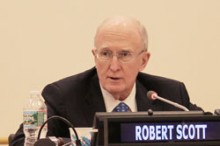 Seeger, writer, folksinger and inspiration for peace activism from the 1960’s to the present, who died the previous week at the age of 94.
Seeger, writer, folksinger and inspiration for peace activism from the 1960’s to the present, who died the previous week at the age of 94.
After defining peace in the words of the US mission to the UN as “ the creation of a lasting reconciliation based on the acceptance of a shared historical narrative” adding “with a system of justice,” he went on to summarize the major causes of war:
- Ambition, the concern with prestige, honor and force by those in power
- Competing ideologies without restraints –as in the Cold War, the era of “containment,” the treatment of women and minorities in various cultures, and sectarian conflicts
- The profound effects of memory and national rivalries, the denial of a shared historical narrative, and the rise and fall of colonialism
- The momentum of militarism, and the tendency to use new technologies unnecessarily if you have them, leading to atomic weapon use, land mines, cluster munitions, and the lack of control of small and conventional arms
- Assumptions about technology providing quick strikes to affect the “enemy” without affecting the aggressor – e.g. drones, NSA surveillance
- Miscalculations about the effects of hunger, climate change, flooding, lack of justice and the rule of law, decent pay and safe work for all, income inequality and poverty – all with the potential for divisiveness in society
- Competition for land and natural resources, including water, as populations become more dense – e.g. the Rift valley in Africa, South Africa and Palestine
- Violations of human rights, especially the rights of the child
- Ethnic conflict arising from lack of a strong national identity
- The failure of governments to implement peace building and reconciliation initiatives
He quoted the scholar Walter Russell Mead on modern peace movements: “In two centuries, peace movements have had little discernable 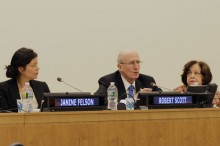 impact on world events, and what effect they have had has often been bad”- e.g.- the peace process following World War I which facilitated Hitler’s plans for a war of revenge. Yet, injecting a note of hope, Mead also suggests two other ideas that Dr. Scott feels we can build upon if we think more specifically than generically:
impact on world events, and what effect they have had has often been bad”- e.g.- the peace process following World War I which facilitated Hitler’s plans for a war of revenge. Yet, injecting a note of hope, Mead also suggests two other ideas that Dr. Scott feels we can build upon if we think more specifically than generically:
- that initiatives to address intractable problems such as war, poverty and justice are best begun at local and regional levels rather than globally -e.g. – combating landmines
- and that stopping a particular war is not the same as stopping all wars. There have been effective initiatives for stopping particular wars, the implication for peace education being that we can prepare citizens to identify particular actions in their own communities, based on empathy and diversity.
In an essay entitled “The Decline of Empathy and the Future of Liberal Education,” the author Nadine Dolby states that “ the journey from sympathy to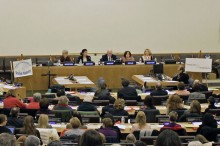 empathy, to informed empathy (i.e. empathy plus knowledge), to social justice is a long process,” not helped by “the innate distancing of social networking technologies, and the rise of violence in video games and other electronic media.” Yet Dr. Scott reminds us that research has shown that cooperation and empathy are as innate to humans and animals as is competition.
empathy, to informed empathy (i.e. empathy plus knowledge), to social justice is a long process,” not helped by “the innate distancing of social networking technologies, and the rise of violence in video games and other electronic media.” Yet Dr. Scott reminds us that research has shown that cooperation and empathy are as innate to humans and animals as is competition.
Teachers are critical in this context. We can foster a culture of peace and non-violence by linking the news, literature and songs to classroom discussions, by teaching critical thinking and writing, by checking assumptions, and emphasizing empathy and cooperation over competition and bullying. We can also teach students how to react and when to react, as does the Heroic Imagination Project www.heroicimagination.org which focuses on everyday heroism, the bystander effect, conformity and peer pressure. We can encourage students to think globally and act locally, and make global connections to local events. He gave two examples: comparing Small Island States to the shorelines of NY and Connecticut, both affected by storms and rising water levels, and early childhood education, whether in distant lands or today’s pre-K debate in NY State. Such comparisons can give rise to discussions about the meaning of state sovereignty and the importance of a homeland, as well as individual rights and responsibilities.
He ended by introducing the other two speakers on the panel, Ambassador Janine Felson, and Dr. Rima Salah.
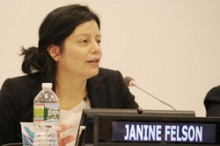 H.E. Ambassador Janine Coye Felson, UN Mission Belize, www.belizemission.com/and Special Advisor to the President of the 68th General Assembly discussed climate change in the context of international peace and security, a connection most people fail to make.
H.E. Ambassador Janine Coye Felson, UN Mission Belize, www.belizemission.com/and Special Advisor to the President of the 68th General Assembly discussed climate change in the context of international peace and security, a connection most people fail to make.
In 2007, the IPCC, (Intergovernmental Panel on Climate Change) issued an assessment, warning unequivocally of the threats to peace and security of issues of food and water viability, natural disasters such as monsoons and flooding, polar ice cap melting, rising sea levels, migration and competition for resources. Ambassador Felson added that attempts to address these issues have been slim, and not societized, and that knowledge of the consequences is lacking. She talked about the impact on economic development as well.
Many people in developing countries are victims of phenomena to which they have not contributed, and fear loss of their homelands. Pacific Islanders, for example, whose land is now one meter above sea level, are being prepared for migration. But being islanders, where are they supposed to go? Is human security/national security an either/or proposition?
The IPCC considers national security in three ways:
- Vital system security – improving the resiliency of states
- Population security – a framework for caring for people in and prior to, emergencies
- State security – concerned with loss of territory
UN Secretary-General Ban Ki-moon’s report on security takes the expanded view that poverty, unemployment, disease and lack of resources are critical, and has emphasized prevention as the most viable policy to address potential conflict. In 2009, the Resolution on Climate Change was passed, significant in that it represents an institutional response to the problem. Yet compliance requires multilateral cooperation, and political acceptance of climate change as a threat to peace is still not universal.
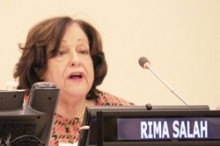 Dr. Rima Salah – clinical professor, Yale School of Medicine Child Study Center, and former Deputy Executive Director of UNICEF began by quoting from the UN Charter – “…determined to save succeeding generations from the scourge of war” and went on to say that today, almost 70 years later, 1.5 billion people still live in countries at war or in situations of violence, without legal standing to effect change.
Dr. Rima Salah – clinical professor, Yale School of Medicine Child Study Center, and former Deputy Executive Director of UNICEF began by quoting from the UN Charter – “…determined to save succeeding generations from the scourge of war” and went on to say that today, almost 70 years later, 1.5 billion people still live in countries at war or in situations of violence, without legal standing to effect change.
She reminded us that the causes of war have always been complicated – poverty, exclusion, discrimination, lack of social cohesion, lack of basic social services such as clean water, nutrition and sanitation, generations of lack of education, and physical and structural violence – and spoke of their impact on children, many of whom die before the age of five. Others are orphaned, displaced, maimed, and traumatized, some becoming victims of trafficking – sex slaves or child soldiers. In too many countries, top-down policies leave children on the ground neglected. Low and middle-income countries, where governments are least able to provide for citizens, are the most affected.
She spoke about her experiences with UNICEF in Sierra Leone, Northern Uganda, South Sudan, Liberia and Congo, and UNICEF’s “Back to School” campaign, to provide children with pens rather than guns. She also spoke of strong women and children who contribute to peace, citing the women in Liberia who organized protests against dictator Charles Taylor, and believes that investing in children in their formative years can promote resilience, social cohesion and peace.
In the last 15 years, there has been a greater awareness of issues of children and armed conflict, resulting in a Consortium on Formative Childhoods: A Path to Peace and a Sustainable World, initiated by Dr. Salah, to orchestrate the role of women and children as agents of peace, with a focus on early childhood education. Participating organizations include the Mother/Child Program in Early Childhood Development, which promotes good parenting in refugee camps in Turkey, the Yale University Child Study Center, UNICEF, the Alliance of Civilizations and the Fetzer Institute in Kalamazoo, Michigan, which focuses on love and forgiveness.
BEST PRACTICES AWARDS
CTAUN member and Best Practices Coordinator Joan Goldstein introduced this year’s winners:
Julia Roche from Canberra, Australia – whose program was entitled: “United We Stand,” explored the role of the UN, among other activities, through a program involving Student Ambassadors, a celebration of UN Day, and having children rewrite the Convention on the Rights of the Child in language at their level. In accepting her award, Ms Roche stated emphatically, “Teaching about the UN should be in the curriculum of all schools.”
Katherine Makela – Principal of the Lillian M. Dunfee Elementary School in NJ – worked to promote positive behavior and appropriate expectations for children through a project called ROAR – an acronym for Respect, Optimism, Awesome Achievers, and Responsible.
Michael Healey and Michele Vella, a husband-wife team from Stroudsburg, PA, worked with Ramu Damodaran, Director of the United Nations Academic Impact (UNAI) on developing a Public Health and Social Justice curriculum focused on AIDS and World AIDS Day.
(For more detailed information, see the Best Practices Awards Section on our website)
SPOTLIGHT
Dr. George Lopez, Vice-President, Academy for Conflict Management and Peace Building, United States Institute of Peace www.usip.org and the Joan B. Kroc Institute of International Peace Studies at the University of Notre Dame; introduced by CTAUN member, Dr. Thomas Ward.
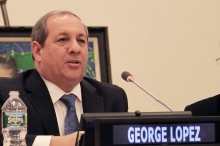 In the late 1980’s, Dr. Lopez wrote an essay entitled “Peace Studies and Education at the Crossroads: Where Else Should We Be?” Today, he says, we are at another crossroads, in an era of “Peace hyphens” – i.e. Peace-Support, post-violence Peace-Building, and Peace-Enforcement (the UN’s “Blue Helmets.”) He told us that an entire generation of children has been traumatized by the war in Syria. The question is – how to prepare agents of change under conditions of violence, when 50% of conflicts that come to the peace table are recidivist.
In the late 1980’s, Dr. Lopez wrote an essay entitled “Peace Studies and Education at the Crossroads: Where Else Should We Be?” Today, he says, we are at another crossroads, in an era of “Peace hyphens” – i.e. Peace-Support, post-violence Peace-Building, and Peace-Enforcement (the UN’s “Blue Helmets.”) He told us that an entire generation of children has been traumatized by the war in Syria. The question is – how to prepare agents of change under conditions of violence, when 50% of conflicts that come to the peace table are recidivist.
Rather than wondering who of our students will be the next great political leader of social change, Dr. Lopez maintains that peace education is for everyone. Medical students should be introduced to Doctors Without Borders, law students to teaching the Rule of Law. Business majors should be encouraged to take the risk of starting new companies in the developing world, and there should be a peace studies program for police officers, overseas as well as at home. What else can we as teachers and concerned citizens do? We can improve textbooks so as to reverse stereotypes, we can build cultural literacy, as well as reading skills, and we can teach our students to make the global-local connection. He closed his presentation by saying: “Peace education is citizen education; the goal is universal responsibility.”
POSTER DISPLAY
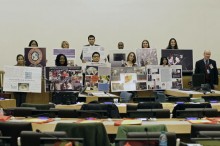 Dr. Thomas Ward, CTAUN member and Dean of the International College, at the University of Bridgeport introduced 11 poster contest winners from Bangladesh, Eritrea, Guyana, Japan, Nepal, Pakistan, Syria, Turkey, and the US. These student artists, currently studying at the US Colleges (Baruch, Bridgeport, College of New Jersey, St. John’s, and Sacred Heart) presented posters on the theme of Peace, many inspired by stories of their own experiences.
Dr. Thomas Ward, CTAUN member and Dean of the International College, at the University of Bridgeport introduced 11 poster contest winners from Bangladesh, Eritrea, Guyana, Japan, Nepal, Pakistan, Syria, Turkey, and the US. These student artists, currently studying at the US Colleges (Baruch, Bridgeport, College of New Jersey, St. John’s, and Sacred Heart) presented posters on the theme of Peace, many inspired by stories of their own experiences.
Contest winners displayed their posters and spoke with conference participants during the lunch break as well. Each was awarded a certificate of appreciation by CTAUN Chair, Anne-Marie Carlson.
LUNCH/ INFO FAIR EXHIBITS
organized by Dr. Ruth Nielsen, CTAUN Info Fair Chair
There were 21 exhibitors including UN Agencies and NGOs – they are listed at the end of this report
PRACTICAL STRATEGIES FOR PEACE EDUCATION
Tony Jenkins, Vice President for Academic Affairs, National Peace Academy www.nationalpeaceacademy.us
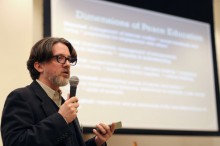 began with a power-point presentation proposing that we consider that all education is peace education, and no education promotes peace when it is for some at the expense of others. He then went on to give us the definition of peace from The Earth Charter: “Peace is the wholeness created by right relationships with oneself, other persons, other life, the Earth and the larger whole of which we are all a part.” “Right relationships are ongoing,” he added, “and not an end result.”
began with a power-point presentation proposing that we consider that all education is peace education, and no education promotes peace when it is for some at the expense of others. He then went on to give us the definition of peace from The Earth Charter: “Peace is the wholeness created by right relationships with oneself, other persons, other life, the Earth and the larger whole of which we are all a part.” “Right relationships are ongoing,” he added, “and not an end result.”
“Education should be for and about peace,” he said. He gave us a sheet displaying a matrix of the five focal points of peace education from “Peace, Peacebuilding and Peacelearning: A Holistic Introduction – A 90 Day Study Guide for Peacebuilders of All Ages” (downloadable from www.nationalpeaceacademy.us/edresources click on study guide
- Personal – involving internal conflict, personal decision making, reflection, journal writing, meditation, perspective taking, and self awarenes
- Social – interpersonal conflict, managing differences, reflective listening, mediation, dialogue, empathy, conflict resolution and transformation
- Political – democracy, collective and cooperative decision making, inquiry, critical thinking, consensus building
- Institutional – institutionalizing norms and values, community wholeness, restorative justice, cooperative planning, understanding of the roles and purposes of institutions, skills of analysis to assess existing institutions
- Ecological – systems thinking, interdependence, experiencing nature, under-standing basic principles of the web of life and ecological responsibility
He demonstrated the strategy of interactive learning by breaking us into small discussion groups with the questions: “What elements in the morning presentations were ‘eye-openers’ to you?” and “What are the dimensions of these issues? How would you teach them?” Strategy suggestions shared by the group included having a “morning broadcast” in schools to share news, facts and opportunities for engagement, application of classroom learning to service learning, and an analysis of Eisenhower’s military/ industrial complex speech.
AFTERNOON PANEL: Solutions for Peace Introduced by CTAUN Vice-Chair Grace Murphy
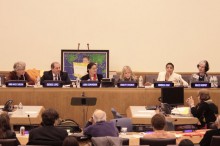 Dr. Lorna Edmundson, Professor Emerita of Wilson College and panel moderator spoke briefly about growing
Dr. Lorna Edmundson, Professor Emerita of Wilson College and panel moderator spoke briefly about growing
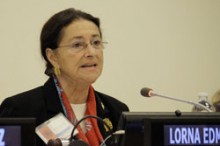 trends toward campus internationalization and service learning projects, enabling students to experience life in a different culture and work on real world problems. She agrees with Dr. Lopez that peace education is multidisciplinary, and believes it should be a lifelong process. Dr. Edmundson then introduced the panelists: Charlotte Mourlot, Minverva Diaz, and Dr. George Lopez.
trends toward campus internationalization and service learning projects, enabling students to experience life in a different culture and work on real world problems. She agrees with Dr. Lopez that peace education is multidisciplinary, and believes it should be a lifelong process. Dr. Edmundson then introduced the panelists: Charlotte Mourlot, Minverva Diaz, and Dr. George Lopez.
Charlotte Mourlot – a 4th Grade teacher at the United Nations International School (UNIS) in NY City, CTAUN member and a trained mediator who 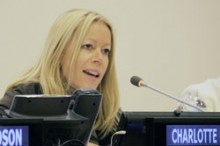 writes a blog about peace education and parenting www.givemypeace.com, began by quoting Cora Weiss, of the Hague Appeal for Peace: “To reach peace, we need to teach peace.” Using a slide show format, she then gave an overview of the composition and work of UNIS, which has children of over 130 nationalities, k-12. Students begin studying about the UN in a vertically integrated curriculum. At the elementary level, they learn about ethnicities and cultures through songs, poems, stories, art events, writing, international food fairs, and bringing peacekeepers into the classroom. They celebrate UN Day, with flags, native costumes and an international breakfast, followed by a UN Day Parade.
writes a blog about peace education and parenting www.givemypeace.com, began by quoting Cora Weiss, of the Hague Appeal for Peace: “To reach peace, we need to teach peace.” Using a slide show format, she then gave an overview of the composition and work of UNIS, which has children of over 130 nationalities, k-12. Students begin studying about the UN in a vertically integrated curriculum. At the elementary level, they learn about ethnicities and cultures through songs, poems, stories, art events, writing, international food fairs, and bringing peacekeepers into the classroom. They celebrate UN Day, with flags, native costumes and an international breakfast, followed by a UN Day Parade.
Beginning at the Jr. High level, in ascending years they learn about peacekeeping, the rights of the child, Action–Earth, UNICEF and the rights and responsibilities of citizenship. She talked about a specific strategy called “Peace Tables,” which exists in every classroom, along with a peace bench in the playground, to foster conflict resolution skills. It serves as a link to the Security Council’s peace table. Each classroom peace table is unique and designed by the children. They contain picture books, posters, a globe, and artifacts from around the world, perhaps a photo of Norman Rockwell’s Golden Rule mosaic hanging in the UN, or a sign with the quote “Let there be peace on earth and let it begin with me.” (For some of Charlotte’s picture book recommendations, see the Teacher Resources section of our website.)
She talked about creating a process for how to use the peace tables, and doing so with children. She explained about using the language of conflict resolution “I messages” rather than the accusatory “You…” and shaking hands. Not all conflicts can be easily resolved, but empathy can be developed for the other’s point of view. In response to a conference attendee’s question about how this is done, she spoke about listening skills and reflecting back what you heard the other say. The goal is for children to learn to solve problems unaided, with little teacher intervention. This requires training and consistency. She does not recommend using peace tables where bullying and repeated conflict is involved.
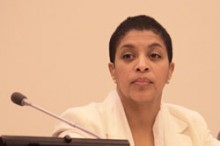 Minerva Diaz – an artist focusing on human and global issues, notably peace, the environment and health; representative of Peace Jam, an educational initiative that uses Nobel Laureates – their challenges, failures, aspirations and successes as role models for students, aged 5-25, particularly those at risk.
Minerva Diaz – an artist focusing on human and global issues, notably peace, the environment and health; representative of Peace Jam, an educational initiative that uses Nobel Laureates – their challenges, failures, aspirations and successes as role models for students, aged 5-25, particularly those at risk.
Such a strategy enables students to see themselves as agents of change, not only in their own lives, but in their communities, as well. Peace Jam has been operating for 17 years, with affiliates worldwide. Ms Diaz introduced it to NY. With 13 laureates on board, she partners with Google to facilitate online chats between students and laureates, and holds an annual conference with Nobel Laureates present (For more detail, see the Resource section of our website or go to www.peacejam.org )
Towards the end of her presentation, Ms Diaz displayed one of her paintings, depicting a young girl reading a book of thank-you letters with a 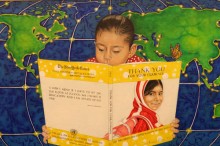 cover photo of Malala, the articulate Pakistani girl who was willing to give up her life for the right of girls to be educated. “I don’t mind if I have to sit on the floor. I want an education and I’m not afraid of anything,” read one of the letters. The message of the painting is to encourage children to read about peers who are inspirational figures, as an antidote to the values of materialism and consumerism in much of the other media.
cover photo of Malala, the articulate Pakistani girl who was willing to give up her life for the right of girls to be educated. “I don’t mind if I have to sit on the floor. I want an education and I’m not afraid of anything,” read one of the letters. The message of the painting is to encourage children to read about peers who are inspirational figures, as an antidote to the values of materialism and consumerism in much of the other media.
Dr. George Lopez, who was our morning Spotlight speaker – US Institute of Peace (USIP), Kroc Institute at Notre Dame, opened his presentation stating that this is the 30th anniversary of the USIP, which works to train educators and university students in institutions of higher learning who are coping with post-violence situations. They offer direct action strategies of non-violence, using Gandhi and Martin Luther King as role models. He told us that while non-violent citizen peace movements lost favor for a while, they remain potentially powerful. “Violence can’t be undone by a peace treaty,’’ he told us, “only by peace building, which may take 50 years or more.” He differentiated between conflict resolution, which is content-centered (treaties), and the current focus on conflict transformation, which is relationship-based (attitudes).
He spoke about the power of active listening, and urged us to engage students in listening. We need to listen, not just on an interpersonal level, diplomat to diplomat, but on a societal one as well. We, as a society, need to ask ourselves, “What are five things we need to know about the other side’s perspective on an issue?” – e.g.-”What are five things we need to know about the Iranian perspective on the nuclear arms talks?” Countries which have come to recognize the need for listening to one another – Libya, Sudan, Uganda and Colombia – are all currently engaged in developing curricula for peace education. In a Q&A session, Dr. Abdelkadar Abbadi, a long–time diplomat at the UN, and member of CTAUN’S Advisory Council, mentioned the UN’s Mediation Support Unit, and the Folke Bernadotte Society in Sweden as well.
CLOSING KEYNOTE
Cora Weiss, President of the Hague Appeal for Peace and Honorary Patron of CTAUN
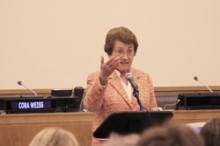 She began her power point presentation explaining the origin of the peace symbol, which is a combination of the letters ”N” + “D” for nuclear disarmament. Click here to view the peace symbol origin
She began her power point presentation explaining the origin of the peace symbol, which is a combination of the letters ”N” + “D” for nuclear disarmament. Click here to view the peace symbol origin
She went on to say, “ Teachers are the world’s most important people, because when Article 26 of the Universal Declaration of Human Rights is fully implemented, everyone in the world will pass through your hands.” In response to the oft-proclaimed protest of teachers: “With all the current mandates and demands on our time, how am I going to fit one more subject into my curriculum?” she reminded us that Peace Education is not a separate subject, but can be integrated into our curricula no matter what we teach. (See her suggestions below.)
Peace Education doesn’t come with our DNA. It should be taught in teacher-training schools, and to education authorities, if we are to expect policy change. We can’t have a mandate without trained teachers (and policy makers).
To naysayers, she reminded us that change does happen, and that it is individuals and civil society groups that make it happen, in local victories, accomplished one step at a time. She cited the repeal of the “stop and frisk” policy in NY, same sex marriage, the Land Mine Ban Treaty, and the 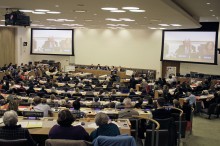 women in 2000, who managed to get the UN to pass Security Council Resolution 1325, calling for women at all levels of governance and at all peace-making tables. Toward the end of her speech Ms Weiss also reminded us that over time, we have won greater victories – abolished slavery as an institution, colonialism, and apartheid. Why not war?
women in 2000, who managed to get the UN to pass Security Council Resolution 1325, calling for women at all levels of governance and at all peace-making tables. Toward the end of her speech Ms Weiss also reminded us that over time, we have won greater victories – abolished slavery as an institution, colonialism, and apartheid. Why not war?
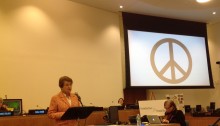 On the issue of Disarmament, she maintains,” You can’t say you are decreasing the number of nuclear weapons you have and modernize the rest, keeping them on alert, ready for war… 55,000 weapons have been eliminated since President Reagan met with (Premier) Gorbachev, but 17,300 remain – more than enough to wipe out civilization and the planet.” She urged us, as part of our own education, to learn the rules we are supposed to adhere to, by reading the UN Charter, the Universal Declaration of Human Rights, and the Hague Agenda for Peace and Justice in the 21st Century.
On the issue of Disarmament, she maintains,” You can’t say you are decreasing the number of nuclear weapons you have and modernize the rest, keeping them on alert, ready for war… 55,000 weapons have been eliminated since President Reagan met with (Premier) Gorbachev, but 17,300 remain – more than enough to wipe out civilization and the planet.” She urged us, as part of our own education, to learn the rules we are supposed to adhere to, by reading the UN Charter, the Universal Declaration of Human Rights, and the Hague Agenda for Peace and Justice in the 21st Century.
She offered several suggestions for teachers to develop, on how to integrate Peace Education into the curriculum:
- Make teaching about the UN part of your curriculum (See the UNIS program presented by Charlotte Mourlot, above. Also, in our resources section, see the article by Anne-Marie Carlson, “Is it Still Necessary to Teach About the UN?” and go to our Resources for Teaching about the UN – which has books at all levels, media resources, teacher packets, and links to other sites.)
- Make Reconciliation the 4th ‘r’. She spoke about Israeli and Palestinian parents whose children have been killed by the other creating together a ‘Circle of the Bereaved”. (Check our peace resources for films like “Bridge Across the Wadi” and “One Day After Peace” which are both about reconciliation in the Middle East, or watch the commercial film “Invictus” about how Nelson Mandela used sports as a vehicle for reconciliation, by integrating the South African springbok soccer team-available on DVD.)
- Read a copy of the paper jointly written by a Palestinian man and an Orthodox Israeli woman, calling for eliminating hatred in textbooks, re-training teachers from both sides to teach without attacking the “other,” and student exchange, which will be on the CTAUN website. (Having students go through their own history texts to find examples of stereotyping and subtle discrimination could be a way of counteracting them. On student exchange, go to www.afs.org ).
- Only with an agreed common narrative for the causes of a war can reconciliation be possible. An end to the fighting is not an end to the conflict. In keeping with the initiative by Jordan’s ambassador to add a “historical advisory service” to peacekeeping, select an issue involving violence and explore its historical causes. (See Facing History and Ourselves under our Human Rights resources for ideas and support.
- Create a “solution circle” in your classroom. Students pick issues, and send their solutions to decision makers, including UN ambassadors (google contact info-UN ambassadors)–it’s ok to express your opinions to them. She also suggested that students think about mediation, negotiation, diplomacy and teaching as future careers. (The NY Institute of Peace offers courses in mediation www.nypeace.org/trainings )
- It costs $1 million a year for every soldier deployed in Afghanistan. Global military spending has increased 50% over the past 10 years. For math classes, if possible, look at the US and UN budgets and research the amounts spent on health care, education, housing, the military and national security. What % of our national budget goes to the UN? What % of the UN’s budget goes to UN Women to protect women’s rights? Or to WHO (the World Health Organization), to prevent disease? To UNICEF etc.? (For military budgets, go to the website of the Project on Government Oversight www.pogo.org click on Our Work, then on the Strauss Military Reform Project, then on defense budget.)
- 2014 will be the centennial of World War I. This presents possibilities for discussing war and peace in geography, history, ethics, foreign policy and English literature classes.
- The Global Peace Index put out by the Institute for Economics and Peace www.economicsandpeace.org measures the peace status of countries according to a set of attributes available on their website. Try making a peace index of your community or state. What attributes would you look for?
- Climate change encourages violence, war and human rights violations. The Pentagon in 2004 warned that by 2020 climate change would unleash mega droughts, mass starvation, even nuclear war, as countries battle over river valleys and other sources of food and water. (To teach a unit on water, see our resources on The Global Challenge of Water.)
- The ambassador from Belize (above) spoke about small island states suffering from climate shock. If possible, engage someone in your school or community who comes from a small island to lead discussions on climate justice.
CLOSING
Peter Yarrow, founder, with Educators for Social Responsibility, of Operation Respect, peace activist and folk singer (Peter Paul & Mary) – spoke 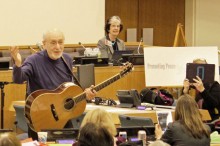 about empowering children to create peace by active listening and role playing, giving them a sense of having initiated it. He gave an example of his work with Palestinian children to enable them to understand that both sides are hurting, calling work of this kind “creating dialogues of the heart.” He
about empowering children to create peace by active listening and role playing, giving them a sense of having initiated it. He gave an example of his work with Palestinian children to enable them to understand that both sides are hurting, calling work of this kind “creating dialogues of the heart.” He
commented that children don’t sing much anymore, and urged us to bring the joy of song back into the classroom, as a way of passing down our cultural heritage and for fun. He suggested, as a strategy, having them speak the lyrics to the tune of a song until they feel comfortable with singing it. He then went on to sing his quintessential peace song “Where Have All the Flowers Gone?”, urging conference attendees to sing along. He followed it with “Have You Gone to Jail for Justice?”, “Don’t Laugh at Me,” the theme of Operation Respect, (which he told us exists in 22,000 schools worldwide) and finished with a rousing rendition of “If I Had a Hammer” – a wonderful way to conclude our conference. His music can be downloaded free from the Operation Respect website. www.operationrespect.org
InfoFair Exhibitors:
The Asia Society www.asiasociety.org
Arigatou International www.dayofprayerandaction.org
The Atom Project www.theATOMproject.org
Department of Public Information/Outreach Division www.dpi.org
Global Communities for Peace www.globalcommunitiesforpeace.com
Global Concerns Classroom www.gcc.concernusa.org
International Rescue Committee www.rescue.org
Life Vest Inside www.lifevestinside.org
The Muhammad Ali Center www.alicenter.org
Office of the Special Representative of the Secretary General for Children and Armed Conflict www.un.org/children/conflict
Operation Respect www.operationrespect.org
Peace Boat www.peaceboat-us.org
Refugees International www.refugeesinternational.org
School of Global and Ethical Studies www.schools.nyc.gov
Seeds of Peace www.seedsofpeace.org
UNESCO www.unesco.org
seeks to establish peace on the basis of humanity’s moral and intellectual solidarity, mobilizing education to put every child in school, protecting cultural diversity and protecting freedom of expression
UNICEF www.unicef.org
United Nations International School www.unis.edu
UN Office for Disarmament Affairs www.un.org/disarmament
U.S. Fund for Unicef www.teachunicef.org — provides educators with global learning resources for grades Pre-K to 12, including videos, web-based lesson plans, school-based programming and more
U.S. Institute for Peace www.usip.org
America’s global conflict management center; works to prevent, mitigate and resolve international conflict without resorting to violence through the teaching of conflict management skills.
With thanks to Peggy Montgomery for assistance with copy-editing, Virginia Gamba, Dr. Robert Scott, Charlotte Mourlot and Cora Weiss, who provided us with printed copies of their remarks, and, for additional notes, to Dr. Nancy Brown, Viktoria Brezheniuk, Martha Chatterjee, Ann Grosjean, Lochie Musso and Julie Kleszczewski. Toni Giangrande -Editor
Photographs by Don Carlson
In July, on her 16th birthday, Malala Yousafzai, shot in the head last year by the Taliban on her way to school, electrified the world with her stirring words to a UN Youth Conference in New York City. “Let us pick up our books and pens,” she said. “They are our most powerful weapons. One teacher, one book, one pen can change the world.” Let us follow her lead!

